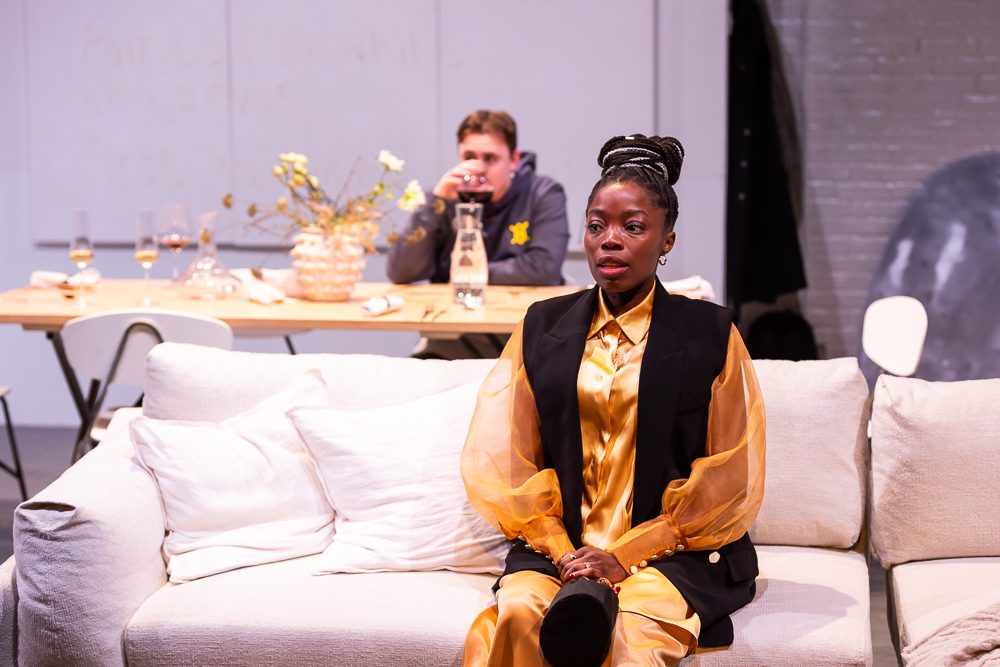
Culture Writer Daisy Griffin reviews The White Card at the Birmingham Rep, a play which interrogates white liberals who ignore their privilege and its role in the oppression of people of colour
Content Warning: This article discusses a play that contains themes of racism.
Claudia Rankine’s captivating and timely debate-play, The White Card, confronts the privilege of whiteness, which too often goes unnoticed and unchallenged in contemporary discourses regarding race. The play’s opening scene is set in the Manhattan loft apartment of art-collectors Charles and Virginia Spencer, joined on stage by art dealer, Eric. The group await the arrival of Charlotte, played by the poised Estella Daniels, a black contemporary artist whose photography reconstructs unseen moments of racial violence.
Charlotte has been invited to dinner by the couple, who have shown an interest in her work; they specialise in the collection of African American art which hangs, as if curated, on the white walls of their dining room. Though these artworks are not physically present in Debbie Duru’s set, they are instead suggested to the audience in the form of enlarged, white gallery-style descriptor panels.
The initial interactions between Charlotte and the family expose the workings of white male patriarchy and its control over money and power. On countless occasions, Charlotte’s work and the themes explored through her photography are explained back to her by the white characters on stage. Though the opportunity offered to her here demonstrates support for people of colour, the interaction also shows how easily this can be taken away, exposing complications regarding authorship and voice.
“Encouraging everyone to get along and simply look beyond racial differences, Virginia is unnervingly blind to her own privilege
Enter Alex, the socially conscious activist son of the family, joining the family dinner late having attended a BLM protest. Hailed by his mother as the ‘superhero’ of the family, Alex’s passion and awareness of the realities of racism are clear. However, notions regarding white saviorism are apparent and his lack of lived experience makes him inherently detached and entirely distanced from the real experiences of racial injustice.
Different degrees of white liberalism are demonstrated in the behaviour of the white members on stage in the opening scenes of the play. This is most obviously demonstrated by Virginia and Eric, both quick to cheer on and defend black icons Serena Williams and Michelle Obama, and yet quick to flinch away when confronted by the realities of present racial conflict. Encouraging everyone to get along and simply look beyond racial differences, Virginia is unnervingly blind to her own privilege.
As the conversation quickly escalates, Charlotte, going unnoticed by the family, lies down on the floor, marking the transformation of the white-washed set design. To the sound of Childish Gambino’s ‘This is America’, the two left walls of the set spun around, exposing their black surfaces. Five ensemble members entered the stage, dismantling what appeared to be an abstracted work of art on the back wall of the set. Composed of five individual, separate shapes, these were turned around, showing mirrored surfaces which were held up to the audience. Reflecting our faces in their surfaces, the play’s relevance to the UK, and the themes discussed within it, were made particular urgent and apparent in this instance.
“To the sound of Childish Gambino’s ‘This is America’, the two left walls of the set spun around, exposing their black surfaces
The transformation of the set marked a change in location, a year on, in Charlotte’s studio, with Charles paying the artist an unexpected visit. However, the power dynamic between the characters, so apparent in the first part of the play, is turned on its head as Charlotte confronts Charles by posing questions to him in the same way he once looked at her as a black artist.
It is here that the artist’s shift in focus of her work is revealed to the audience; upon realising that she could no longer continue reducing blackness to suffering, allowing the viewer to ignore the role of whiteness in racial oppression, Charlotte’s new work makes visible the complicity of white people in racial violence.
“The play acts as a potential conduit through which to inspire further discussions and continue this much-needed conversation
Presented powerfully by a strong cast, The White Card takes a fresh perspective in approaching age-long discussions regarding race relations, exposing just how the normalisation of whiteness has meant that it continues to fly below the race radar. As referred to by Rankine herself, the play certainly acts as a potential conduit through which to inspire further discussions and continue this much-needed conversation.
Rating: 4/5
Enjoyed This? Read more from Redbrick Culture here!
Comments